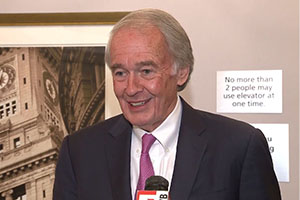It's almost time for daylight saving time again. Will it one day be permanent?
Mar 3, 2023Are you tired of moving your clock ahead an hour in March, only to move it back again in November?
The second Sunday in March — this year, that's March 12 — serves as the beginning of daylight saving, while the first Sunday of November marks its end.
Last year, U.S. Sen. Ed Markey, D-Mass., was among several senators to co-sponsor the Sunshine Protection Act, filed by U.S. Sen. Marco Rubio, R-Fla., and which would make daylight saving time (DST) permanent. It passed the Senate by unanimous consent.
 "Studies show that extending DST year-round would have positive impacts on public health, the economy, and would cut energy consumption," Markey said on his website.
"Studies show that extending DST year-round would have positive impacts on public health, the economy, and would cut energy consumption," Markey said on his website.
"No more switching clocks, more daylight hours to spend outside after school and after work, and more smiles — that is what we get with permanent daylight saving time," Markey said at the time. "U.S. Senate passage of the Sunshine Protection Act means brighter days ahead for Americans, all year round."
Where does the legislation stand?
The 117th Congress ended without a House of Representatives vote, which would then needed to be followed by a signature from President Joe Biden. The proposal now needs to be reintroduced.
But it isn't just the federal government that has been mulling a change. According to the Bureau of Transportation, 29 states — including Massachusetts, New Hampshire and Vermont — introduced legislation between 2015 and 2019 to "abolish the twice-yearly switching of clocks."
Light control: What is the future of daylight saving time? Year-round change depends on federal vote.
Where did DST come from?
Daylight saving time was first enacted by the federal government on March 19, 1918, as a measure to save on fuel costs during World War I by adding an extra hour of sunlight to the day, according to the Library of Congress.
But daylight saving didn't become federal law until 1966, with passage of the Uniform Time Act . It established daylight saving time from the last Sunday of April through the last Sunday of October.
The law has since been tweaked — including a year-round DST period ordered by Congress during the 1973 oil embargo from January 1974 to April 1975 to study its effects on energy consumption. But after public outcry, it was quickly amended to allow for a return to standard time during the winter months.
In 2007, DST was extended to its present form, from the second Sunday in March through the first Sunday of November.
Two states — most of Arizona and Hawaii — remain on standard time year round.
Some don't want DST to be permanent
Dr. Anthony Izzo, medical director of sleep at St. Vincent's Hospital in Worcester, calls the twice-a-year time changes "a relic of a bygone age."
But rather than make daylight saving time permanent, Izzo said many sleep doctors instead favor that standard time — the period we're now in — be permanent. He said moving to year-round DST would have serious effects.
"From March to September (when we spring forward), we all want to stay up a little later but when we do that, we are losing an average of 21 minutes of sleep" during that time period, Izzo explained. "We want to stay up later, but we don't get to get up any later."
He added a change to permanent DST would also result in darkness in the morning hours during the work and school commute.
"I certainly don't want my 9-year-old waiting outside in the dark for the school bus," he said, noting a permanent switch to DST would result in people "going to school and work in darkness for one-third of the year."
Izzo pointed out that as clocks change in March each year, he sees an uptick in incidents the day after the switch.
"We always see that is the day with the highest number of car crashes in the United States," he said. "Strokes also go up 9% the day after, and there is a 24-50% increase in heart attacks."
Why do people have such trouble with time changes? Izzo pointed to circadian rhythms. Put simply, "the whole nation basically gets jet-lagged. And we all know how crummy we feel when that happens."


